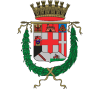The tower, which is still the distinctive feature of the building, dates back to the period of the Commune, when Padua was a city of numerous waterways and mills, and its river port was the centre of intense trading activity.
Excavations have revealed evidence that there were houses on this site as early as the beginning of the eighth century B.C., with manufacturing activities centring around the production ceramics. As for the palazzo itself, it took on the form of a residence+tower in the late twelfth/early thirteenth century: such a structure served both to express the family’s power and to provide defence when needed.
The Zabarella were part of the small circle of powerful families centred around the court of the Carraresi, who governed Padua in the fourteenth century. They would maintain ownership of this palazzo for more than four centuries, leaving it with a largely-unchanged interior layout but with a radically modified facade. The neoclassical frontage was, in fact, added in the early years of the nineteenth century and was designed by the well-known architect Daniele Danieletti. The main change to the interior decor was the addition of nineteenth-century work commissioned by Giacomo Zabarella, the last member of the family; the artists involved were Giuseppe Borsato, Giovanni Carlo Bevilacqua and Francesco Hayez.
Now the premises of the Bano Foundation, the palazzo is home to a privately-run cultural centre dedicated to the study and promotion of the arts.












